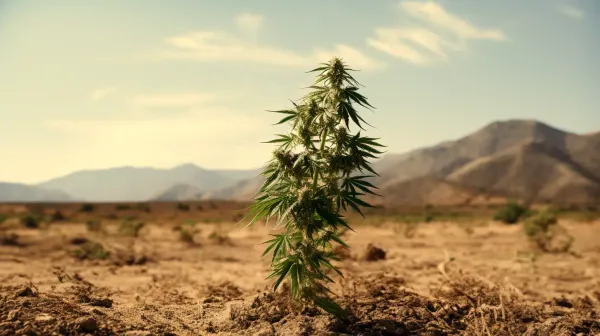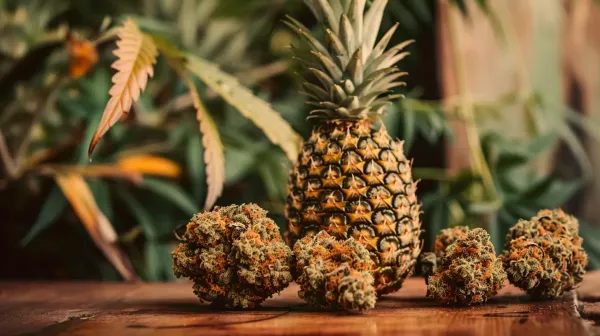Seeds and strains
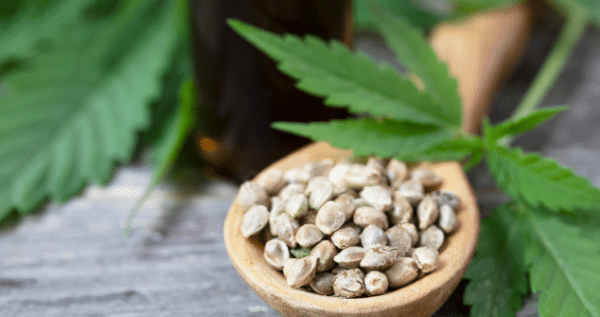
You now know about the different types of marijuana and the difference between feminized and autoflower seeds.
But how do you determine which type will grow best in your climate and which plant is easy to start with?

Super Silver Haze
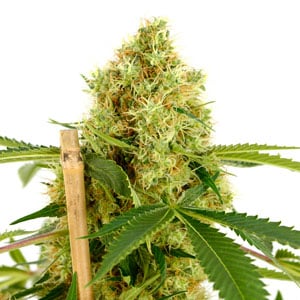
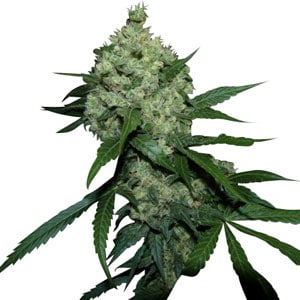
In this course I elaborate on the characteristics of the different types, so you can make an easy choice.
I also tell you about my favorite strains and which plants you should definitely grow at some point.
Cannabis Indica
The indica variety comes from a number of different places including Kashmir, Morocco, Afghanistan, and Tibet.
These locales are well-known for their tradition of producing hash and kif, two THC-filled byproducts of the cannabis plant.
Plants are tend to be shorter (around 3 to 6 feet tall) and contain broad leaves, dense foliage, and a dark bluish green hue that can appear purple sometimes.



During the maturation process, indica plants can start to turn even more purple.
They will also produce thick, dense buds.
The characteristic “skunky” aroma and taste of indica is a defining property of its smoke.
When smoking, you tend to feel the relaxing and almost hypnotic effects in your body more than your brain.
Plant features:
- Originally from Asia, Morocco and Afghanistan
- Small plant with wide, thick leaves
- Flowering time between 7 and 9 weeks
- Relaxed high
Cannabis Sativa
Sativas are a tropical variety originating out of places like Mexico, Colombia, and Thailand.
Despite the fact that these plants come from warmer climates, they have proven to be adaptable to colder temperatures.
They are tall, slender plants that can reach up to between 8 and 12 feet.
Unlike the indica variety, sativas have thinner leaves and a light green coloration.

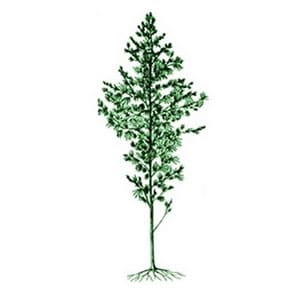

As the buds mature, they start to turn red, but if the climate is colder, they may start to turn purple.
Other sativa strains may have a slight “golden” or yellow hue. Spicy, fruity, and sweet are all ways to describe the smell and taste of sativa plants.
Plant features:
- The high is very cerebral and lively.
- Originally from warm countries around the equator, such as Mexico and Thailand
- Large plant with long, thin leaves.
- Flowering time between 9 and 12 weeks
- Energetic high
Cannabis Ruderalis
Ruderalis is typically cultivated in the northern Himalayas and in a few of the southern former Soviet states.
It grows in a scant, weedy pattern and is typically never cultivated for use as a psychoactive drug.
Hemp cultivation used to be prevalent in places like the mid-western United States, and some extant ruderalis populations can be found in that area.
Wild ruderalis also appears in great quantities in places like Latvia, Belarus, Lithuania, and nearby nations.
Because humans rarely cultivate these plants, they have lost the traits that make them desirable to humans.


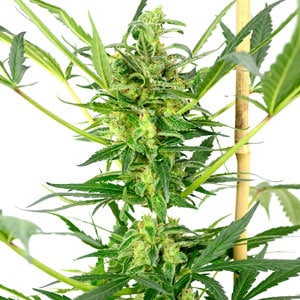
Although ruderalis has a relatively low THC content by comparison to both sativa and indica, they do possess some desirable properties.
Ruderalis is high in cannabidiol (a less potent cannabinoid than THC), and some medical marijuana patients grow these varieties.
But the real draw of ruderalis for some breeders is that the plants can be autoflowering and also highly resistant to pest problems and disease.
Indica strains are commonly crossed with ruderalis strains to produce THC-filled plants that are autoflowering.
Plant features:
- Originally from cold areas such as the Himalayas and Russia
- Very small plant with thin leaves
- Flowering time not dependent on the season
- Is only used for crossing autoflowers
Hybrids
As the term suggests, a hybrid occurs when you cross a sativa with an indica or an indica with a sativa.
Any crossbred plant will contain a certain amount of indica characteristics and a certain amount sativa characteristics.
Every strain has its own unique mix of medicinal characteristics.
Want to gauge how much of a sativa or indica your hybrid plant is? then just take a look at the fingers on the fan leaves.
If the fingers are wider than normal, then you have a “mostly indica” plant.
And if the fingers are thinner than a normal leaf, then you’ve got a “mostly sativa” plant.
One of the most important aspects of choosing a seed is how likely that seed is to thrive in the climate and environment that you intend to grow it in.
Sativas generally take longer to mature than pure indicas, but, with cloning and breeding, you can make crosses between the two that mature in suitable time periods.

Indica
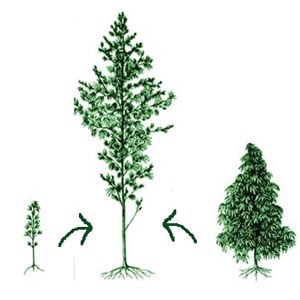

Of course, it’s more vital to take into account the climate when choosing seeds.
What kind of weather do you expect during the growing season?
It’s also always a good idea to look at the average temperatures in your area at the start of spring and fall.
Tropical and southern locales will usually provide plenty of light and warmth for marijuana plants, but northern locations will have to prepare differently.
If the ground is still frozen at the start of spring or if early winter frosts are an issue, then it’s important to have a strain that grows in a shorter amount of time (usually indicas).
You can start later in spring and harvest earlier in the fall so that the cold temperatures do not affect the yield or potency.

Super Silver Haze


It’s also important to note that cannabis plants are incredibly sensitive to light (both the quality and quantity of it).
As soon as a plant receives less than 12 hours of light per day, it will enter the flowering stage.
To induce flowering, many growers will move their plants (if they’re in pots) or put an opaque cloth over them.
Doing this will trick the plants into thinking that fall is coming and they will start flowering.
If you live in a northern locale, inducing flowering might be your best option to avoid a harmful early frost.
You can also try planting a number of different strains to have different flowering times.
Plants have usually matured enough to be forced into flowering by about the third or fourth week of vegetative growth when secondary branching has begun.
We sell all of the above in our seed store. Be sure to sign up for regular updates to get high quality at a bargain!
Regular marijuana seeds
Standard marijuana seeds come from one male and one female parent, and can produce either male or female plants.
It is virtually impossible to tell if a regular seed will turn out to be a male or a female later on.
Of course, after you get to the flowering stage, it is much simpler to identify males and females.
Males will produce oval pods while females will produce a calyx shaped like a teardrop.
The ratio for male-to-female growth with regular seeds is around 1-to-1 (approximately 66% female).
When you start growing, it’s in your best interest to just assume that 50% of the seeds will end up female.
You should germinate a few extra seeds to make up for all the males that you’ll discard later on during the early flowering period.

Female – white hairs

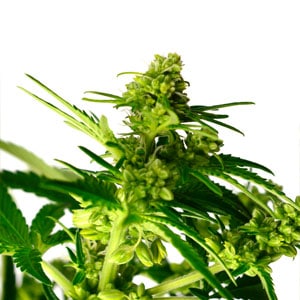
A number of different variables determine whether regular seeds are better suited to some growers than feminized seeds.
The conditions of the grow, the amount of time and space available, one’s preferred choice, and the overall level of expertise all come into play.
If you want to breed cannabis and produce new seeds, then you need both male and female plants, which would require regular seeds.
And if you have no interest in breeding and you just want to have some outstanding bud, then feminized seeds might be a better choice.
Feminized marijuana seeds
By contrast to regular seeds, feminized seeds are bred specifically to eliminate male chromosomes, effectively ensuring that every plant in the crop is going to be female.
If you’re looking for fast and simple cultivation, then feminized seeds are perfect.
Many growers could be wary of growing because it requires the identification of different genders and the removal of males early in the flowering stage.
Feminized seeds effectively remove the need to identify genders because the plants will always be female.
Fem seeds also make sense in other logistical ways.
With regular seeds, growers tend to germinate extra seeds (up to double the intended amount) to account for unnecessary males.
If you use feminized seeds, you only have to germinate as many plants as you need.



White Widow week 8
Another aspect at play is that cannabis is not strictly male or female.
Any marijuana plant can produce flowers of either sex depending on certain conditions.
Certain environmental factors can cause a plant to grow flowers of both sexes simultaneously.
In general, this is a stress response that triggers a survival mechanism in the plant.
Temperature drops, physical harm, issues with the light cycle, and other stressors can cause the plant to produce intersexual characteristics.
The plant’s response to these conditions is to recognize that chances of survival and ultimately reproduction are low.
The plant has a built-in survival response to ensure that it can reproduce successfully.
Under these circumstances, a female plant will produce male staminate flowers so that they can pollinate their own female pistil flowers.
This allows them to produce seeds without the need of a male. In some instances, male plants will produce pistils, but this is rare.

Week 6
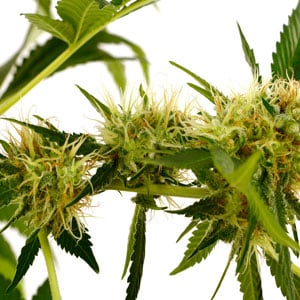
Week 7
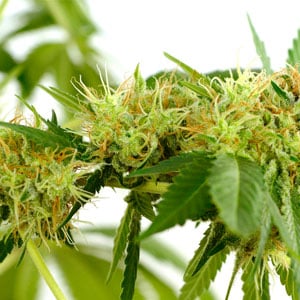
Week 8
Early on, feminized cannabis seeds were produced using two female marijuana plants.
One of the plants in question would have had hermaphroditic tendencies (or, the propensity to create male flowers during stress).
To stress the plant, growers would disrupt the light cycle or prune branches or leaves.
The pollen produced from the hermaphroditic plant would then be used to pollinate the “pure” female.
Unfortunately, the hermaphroditic plants used to pollinate the females could pass that hermaphroditic trait down to the resultant seeds.
This essentially meant that the feminized seeds showed a stronger tendency to be hermaphroditic rather than purely female.
Over time, however, the process of creating feminized seeds improved and became more complex.
With the help of different types of silver, it became possible to force even the purest females to create male cannabis flowers.
Thus, the seeds created from these plants do not have any proclivity toward intersexuality.
All of the feminized seeds on I Love Growing Marijuana are created with this method.
To put it simply, intersexuality or hermaphroditism is a natural part of the marijuana plant’s genome.
Depending on the genetics of each plant, they have a greater or lesser chance of turning hermaphroditic as a result of certain conditions.
These seeds are also NOT genetically modified, meaning that genes are neither added to nor removed from the plant.
The parent plants themselves could be considered “physically modified” by silver, but the seeds themselves are produced naturally through pollination.
Download my free marijuana grow guide and start growing high quality Autoflowering strains
Autoflowering marijuana seeds
Marijuana strains that autoflower are generally small and ideal for outdoor growth.
The daylight hour decrease and a change in season are not necessary for these plants to flower.
Most standard marijuana plants start to flower at the end of summer as days start to get shorter and the amount of light drops.
Plants recognize that they need to start maturing before the onset of winter.
Autoflowering plants are different.
They will enter the flowering stage even if they receive a full 24 hours of light.
For autoflowering, it generally takes 10 weeks from start to finish.
You can also find feminized autoflowering seeds which provide the dual benefits of a quick harvest and no need to identify plant sexes.
These seeds can produce about 2 harvests throughout the span of a standard summer period.
With autoflowering seeds, you can expect between 50 and 500 grams per m2.
This depends on how the plant is maintained and cared for.

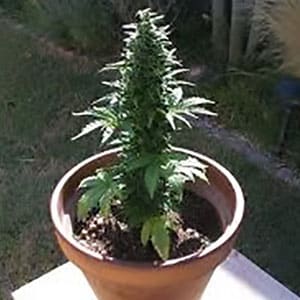

Autoflowering plants stay rather small, so you can plant quite a few for every square meter.
If you want to enjoy some outdoor grass in about 10 weeks, then using these seeds will certainly help.
That being said, the yield and quality are not up to par with seeds that flower regularly.
With feminized autoflowering seeds, you should provide the plant with growth formula for the initial 2 or 3 weeks.
After that, you can switch to the flowering formula.
Auto flower features
- Generally 12 to 23 inches tall (30 to 60 centimeters)
- Suitable for outdoor growth
- Starts flowering automatically after around 3 weeks
- From seed to harvest takes about 9 to 10 weeks
Bergman’s favorites
The one question I get the most is “Which seeds are the best for yield and simplicity?”
Each strain maintains its own unique characteristics, growth processes, and flavors.
But, if you asked me to choose my favorite indica-dominant, sativa-dominant, and ruderalis-dominant strain, then these are what I’d choose:

Everybody needs to cultivate and smoke a little white widow.
It’s one of the most popular strains in Amsterdam coffee shops and it’s loved by indoor growers, too.
It is easy to grow and produces an extensive yield and a fantastic high.
There’s nothing better than white widow, and you can check out this video to see what I mean.
White widow is particularly well-known for the glaze of white trichomes that cover its exterior.
These trichomes are extremely high in THC and white widow benefits from a high potency.
The strain is highly relaxing and has also been used as an appetite booster.
Although it is an indica-dominant strain, it still maintains a large amount of sativa characteristics.
| Plant type | 60% Indica 40% Sativa |
| THC | Up to 19% |
| CBD | Insignificant amounts |
| Difficulty | Easy |
| Climate | Indoors | Temperate | Mediterranean | Steppe |
| Plant size | Average |
| Flowers | 9 weeks |
| Yields | 18 oz per 3x3ft |
| Taste & Smell | Earthy | Herbal | Pungent | Spicy | Sweet | Woody |
| Effects | Creative | Euphoric | Happy | Relaxed | Uplifted |
| Awards | Cannabis Cup Winner 1995 |
Mood enhancement and increased activity can also be experienced when smoking white widow.
The strain is usually compact and rises to medium heights.
The plant’s buds only produce a small amount of amber-colored hairs, but the amount of crystals caked on to the buds is legendary.
It is also resistant to mold and well-suited for colder locales.

Buy White Widow Feminized Seeds
- 60% Indica 40% Sativa
- THC levels up to 19%
- High yielding easy growing plant
- Mind opening euphoric high

Everything about white widow could be said about super silver haze as well.
It’s simple to grow and produces outstanding yields and fantastic highs.
I’m always amazed at how fast super silver haze grows and how much quality bud the plants can make.
| Plant type | 10% Indica 90% Sativa |
| THC | Up to 18% |
| CBD | Insignificant amounts |
| Difficulty | Moderate |
| Climate | Indoors | Temperate | Mold Resistant |
| Plant size | Tall |
| Flowers | 9 weeks |
| Yields | 19 oz per 3x3ft |
| Taste & Smell | Earthy | Herbal | Lemon | Skunk |
| Effects | Creative | Energetic | Euphoric | Happy | Uplifted |
The strain is a perfect blend of notable strains including Northern Lights, Haze, and Skunk.
The scent and taste of super silver haze is like no other.
It packs a fragrant, skunky, and spicy punch that has improved moods and relaxed the body for decades.
You have the combination of a relaxed stone and a stimulated high that proves to be a perfect mix every time.
As long as you provide the plant’s roots with plenty of room to grow, you should end up with outstanding yields.

Buy Super Silver Haze Feminized Seeds
- 10% Indica 90% Sativa
- THC levels up to 18%
- Tall plants for in- and outdoors
- Award-winning, potent, mood-booster

As I’ve noted previously, the only real benefit of autoflowering seeds is the fast flowering time.
Marijuana generally starts to flower when the seasons change and the light cycle diminishes, but autoflowering plants will start blooming in only a few weeks.
They are always rather small and do not produce the highest quality bud, but you can harvest them in no time!
When the season starts, I always germinate a few super skunk autoflowers so I can enjoy a smoke while the standard seeds grow.
This super skunk strain provides all the benefits of the world-renowned super skunk genes with the quick flowering time of cannabis ruderalis.
| Plant type | 80% Indica 20% Sativa |
| THC | Up to 20% |
| CBD | Insignificant amounts |
| Difficulty | Easy |
| Climate | Indoors | Mediterranean |
| Plant size | Average |
| Flowers | 8 weeks |
| Yields | 18 to 21 oz per 3x3ft |
| Taste & Smell | Cheese | Citrus | Earthy | Fruity | Skunky | Sweet |
| Effects | Euphoric | Happy | Relaxed | Sleep | Uplifted |
The growth patterns and beautiful bud structure are consistent and quite aesthetic to look at.
Although short and small, the plant produces substantial colas and plump, THC-riddled calyxes.
The high is immediate and potent, but it is followed quickly by an almost somnolent, long-lasting body buzz.
If you have any questions about what seeds are best for you, please contact one of our expert growers on the forum.
Next up; The basic needs of a marijuana plant

Buy Super Skunk Feminized Seeds
- 80% Indica 20% Sativa
- THC levels up to 20%
- Easy-growing strain that produces high yields
- Skunky smell with strong full-body high

